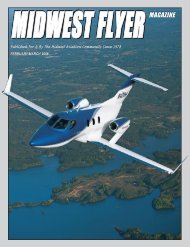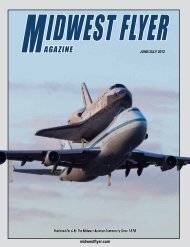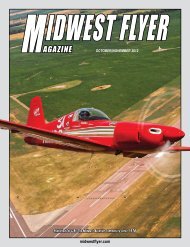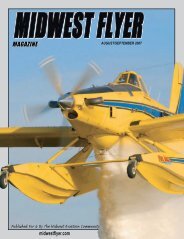AGAZINE - Midwest Flyer
AGAZINE - Midwest Flyer
AGAZINE - Midwest Flyer
Create successful ePaper yourself
Turn your PDF publications into a flip-book with our unique Google optimized e-Paper software.
Piloting Rule Changes<br />
Most of the more significant<br />
action concerns the Sport<br />
Pilot Certificate and pilots<br />
with higher certificates who<br />
choose to exercise Sport Pilot<br />
privileges. And what was not<br />
finally adopted is as significant<br />
as those changes that did in the<br />
end make it into the Federal<br />
Aviation Regulations.<br />
First and most importantly,<br />
the FAA’s proposal to replace<br />
Sport Pilot privileges with<br />
aircraft category and class<br />
ratings was withdrawn by the<br />
agency in the face of resistance<br />
by EAA, which argued that no safety<br />
concerns had been demonstrated as<br />
to why the original system of adding<br />
privileges through proficiency checks<br />
and endorsements by flight instructors,<br />
was not adequate. The FAA ultimately<br />
agreed that the burden of revising the<br />
system was not worth the cost, but it<br />
remains concerned that there is not<br />
adequate documentation of airmen and<br />
their respective endorsements. Those<br />
holding Sport Pilot Certificates should<br />
go to the FAA Airmen Registry and<br />
verify that their current privileges for<br />
category and class are correct, and<br />
contact the FAA if they are not.<br />
The FAA also backed off from<br />
its proposal that flight instructors<br />
no longer be authorized to conduct<br />
proficiency flight checks for the<br />
addition of category and class<br />
privileges to Sport Pilot Certificates,<br />
which would have required all<br />
such checks for additional ratings<br />
be performed by Designated Pilot<br />
Examiners. Consistent with its<br />
decision to withdraw the proposal<br />
to require category and class ratings<br />
discussed above, and facing EAA<br />
opposition for the same reasons<br />
expressed above, the agency agreed<br />
that, given the lack of safety concerns,<br />
the burdens of the change would<br />
not justify the cost. EAA had also<br />
argued that the current lack of Sport<br />
Pilot instructors and Designated<br />
Pilot Examiners for some aircraft<br />
56 AUGUST/SEPTEMBER 2010 MIDWEST FLYER M<strong>AGAZINE</strong><br />
Recent changes to the rules concerning maintenance of light sport<br />
aircraft allow owners to obtain Experimental Light Sport Aircraft<br />
(E-LSA) airworthiness certificates for aircraft originally certificated<br />
as S-LSAs, enabling them to perform their own maintenance,<br />
deviate from dictates of the manufacturers' maintenance manuals,<br />
and even perform their own condition inspections after attending<br />
a 16-hour course. Such aircraft can no longer, however, be used<br />
for flight training or rental.<br />
categories and classes in many parts<br />
of the country, would have altered and<br />
severely impaired the original intent of<br />
the SP/LSA rules.<br />
A consequence of the first two<br />
proposals being withdrawn was the<br />
withdrawal also of a related proposal<br />
which would have eliminated the<br />
need for Sport Pilots to carry their<br />
logbooks with them while in flight to<br />
demonstrate their category and class<br />
privileges. The original rule remains<br />
in effect, but EAA recommends that<br />
pilots carry copies of the relevant<br />
logbook endorsement entries, rather<br />
than the original records, in case the<br />
records are lost, destroyed or stolen<br />
while being carried by the Sport Pilot<br />
on his or her person or in the aircraft.<br />
The FAA proposal, concurred<br />
by EAA, to remove the requirement<br />
that persons exercising Sport Pilot<br />
privileges have make and model<br />
endorsements in a specific set of<br />
aircraft (e.g. tailwheel, less than 87<br />
knots Vh; tailwheel, more than 87<br />
knots Vh; tricycle gear, less than 87<br />
knots Vh, etc.) was adopted, finding<br />
that the now-repealed requirement<br />
was redundant of other training and<br />
proficiency checks. (“Vh” is defined<br />
by the FARs to be maximum speed in<br />
level flight with maximum continuous<br />
power.)<br />
However, the agency also adopted,<br />
over EAA objections, a new regulation,<br />
which requires, apparently, that ALL<br />
Jesse Peckham<br />
pilots operating aircraft with a<br />
Vh of less than 87 knots receive<br />
training and an endorsement<br />
to operate such aircraft, if<br />
they don’t already have such<br />
experience. Perhaps reacting<br />
to the early accident reports<br />
of pilots with higher pilot<br />
certificates and experience in<br />
heavier airplanes transitioning<br />
to very lightly wing-loaded<br />
Sport-Pilot eligible airplanes,<br />
the FAA did not believe that<br />
experience in faster airplanes<br />
would adequately prepare a<br />
pilot to operate a low-speed,<br />
high-drag airplane with a Vh<br />
of less than 87 knots without<br />
additional training. I suspect that<br />
aviation insurance companies probably<br />
agree.<br />
In the opinion of EAA, this new<br />
requirement “effectively obliterated”<br />
this segment of aviation, since it<br />
will be prohibitively burdensome,<br />
it argues, to find an instructor with<br />
an airplane with a Vh of less than<br />
87 knots in which to provide this<br />
training. Time will tell how this<br />
potentially significant change plays<br />
out in practice.<br />
Flight Training Rule Changes<br />
Several significant changes, and<br />
withdrawal of proposed changes,<br />
pertain to Sport Pilot training<br />
activities, including those discussed<br />
already concerning administration<br />
of proficiency checks for additional<br />
Sport Pilot privileges, flight training<br />
in sets of aircraft, and flight training<br />
in aircraft with a Vh of less than 87<br />
knots. Other important developments<br />
should also be mentioned.<br />
In perhaps its most dramatic<br />
position reversal concerning Sport<br />
Pilot flight instructors, the FAA<br />
abandoned its proposal to place all<br />
flight instructors, including those with<br />
Sport Pilot flight instructor certificates<br />
presently regulated under subpart K of<br />
Part 61, together in subpart H, where<br />
all other flight instructor certificates are<br />
regulated. The decision to not pursue
















